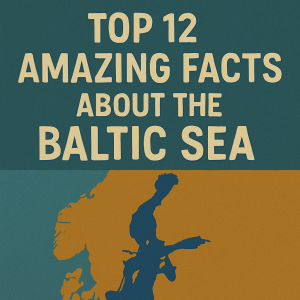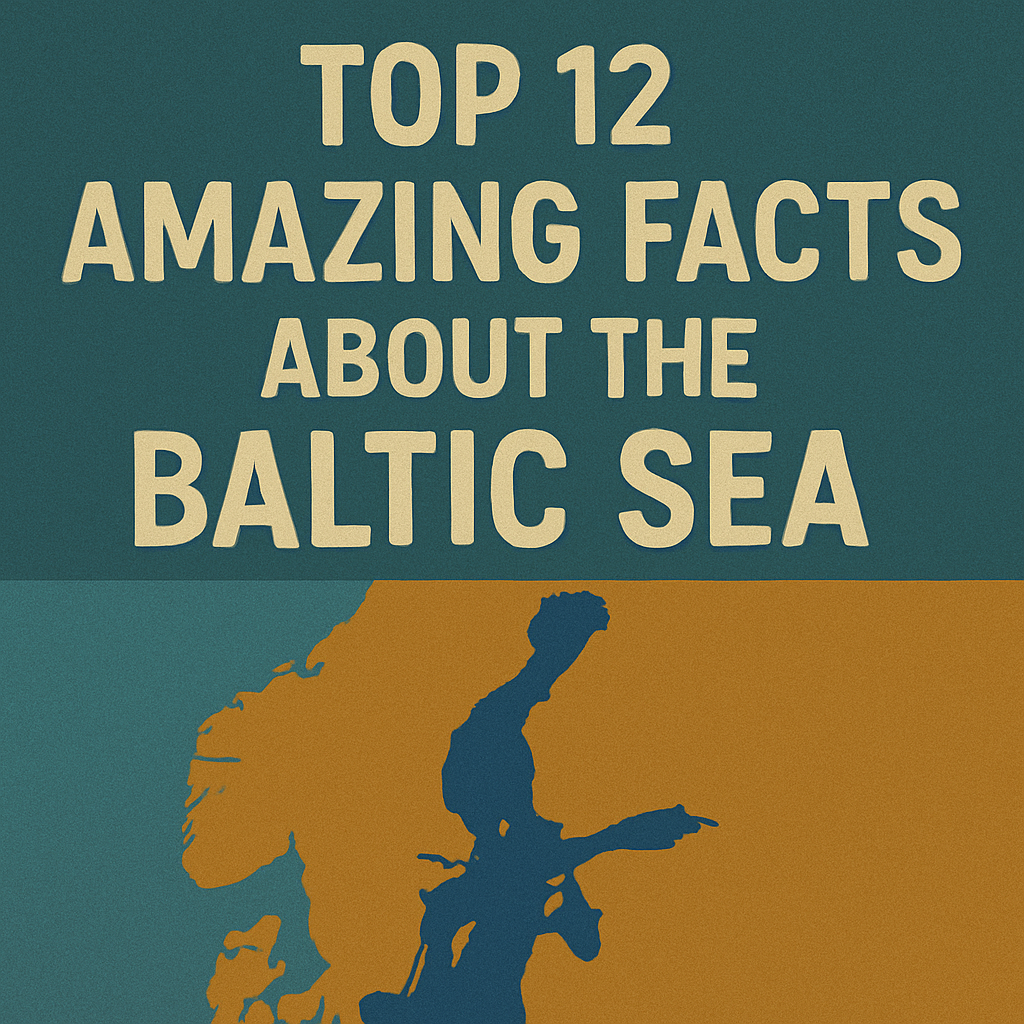 Discover 12 amazing facts about the Baltic Sea, from its unique brackish waters and rich maritime history to its growing role in green shipping. Explore the science, culture, and environmental challenges shaping this extraordinary inland sea.
Discover 12 amazing facts about the Baltic Sea, from its unique brackish waters and rich maritime history to its growing role in green shipping. Explore the science, culture, and environmental challenges shaping this extraordinary inland sea.
The Baltic Sea is not just a body of water between Scandinavia and mainland Europe. It is a complex, fragile, and historically significant marine environment. It connects nine nations, fuels economies, hosts shipping lanes, and holds some of the world’s oldest shipwrecks. Whether you’re a maritime student, a seafarer, or a curious explorer, the Baltic Sea offers more than meets the eye. This guide explores 12 fascinating facts about the Baltic Sea—from science and shipping to mystery and sustainability.
Why the Baltic Sea Matters in Modern Maritime Operations
The Baltic Sea plays a critical role in regional and global maritime operations. According to the European Maritime Safety Agency (EMSA) and EUROSTAT, over 15% of global maritime trade by volume passes through or originates in this region. The sea borders countries like Sweden, Finland, Russia, Germany, Poland, and the Baltic states, and acts as a vital corridor for oil, LNG, bulk goods, and cruise tourism.
But the Baltic isn’t just busy—it’s also sensitive. Its semi-enclosed geography, limited water exchange with the North Sea, and dense coastal populations make it one of the most polluted seas in the world (HELCOM, 2023).
Let’s dive into the facts that make this sea so unique and vital.
The Baltic Sea Is One of the Largest Brackish Water Bodies on Earth
Unlike oceanic saltwater or inland freshwater lakes, the Baltic Sea is a brackish environment—a mix of saltwater from the North Sea and freshwater from rivers like the Vistula, Neva, and Daugava. Its salinity is just 0.3% in the northern parts (Bothnian Bay) and about 1.5% in the Danish Straits, compared to 3.5% in the Atlantic.
This low salinity creates a special ecological niche. Marine organisms must adapt to survive, leading to a unique, though less diverse, ecosystem compared to open oceans.
It Is a Sea with No Tides—Almost
One surprising feature of the Baltic is its minimal tidal range. Due to its semi-enclosed geography and shallow depth (average: 55 meters), tidal effects are almost negligible—usually just a few centimeters.
Instead, water levels vary due to atmospheric pressure, wind, and inflows/outflows through the Danish Straits. These seiche-driven surges are crucial to port operations and have safety implications for moored vessels.
Home to Thousands of Historic Shipwrecks
The Baltic Sea is a maritime archaeologist’s dream. Cold temperatures, low salinity, and anoxic seabed zones preserve shipwrecks in remarkable condition. According to the Swedish National Maritime Museums, over 100,000 shipwrecks are estimated to lie beneath the Baltic.
Famous Example: The 17th-century Swedish warship Vasa was salvaged in near-perfect condition and is now displayed in the Vasa Museum, Stockholm. Likewise, German U-boats, medieval cogs, and trading ships from the Hanseatic League era remain preserved on the seabed.
The Baltic Is a Crucial Hub for Green Shipping
The Baltic Sea is a Sulphur Emission Control Area (SECA) under IMO MARPOL Annex VI, enforcing strict emission limits on SOx (0.10% m/m). Since 2015, ships operating in the Baltic must use low-sulphur fuel, exhaust gas cleaning systems (scrubbers), or alternative fuels like LNG.
Latest Trends:
- The Port of Gothenburg is piloting green corridors with ammonia and methanol bunkering trials.
- The Finnish-Swedish ice class fleet is undergoing LNG retrofitting.
This makes the Baltic a testing ground for IMO’s 2050 decarbonisation targets.
One of the Most Densely Populated Maritime Regions
Nearly 85 million people live in the Baltic Sea catchment area. This creates intense demand for resources, ports, recreation, and tourism. Cities like Stockholm, Helsinki, St. Petersburg, and Gdańsk rely heavily on the sea for economic vitality.
Cruise shipping is a major contributor, with over 5 million cruise passengers recorded annually before the COVID-19 pandemic (CLIA, 2019). Ferries connect cities across borders, making the Baltic a unique arena for short-sea shipping.
Home to the World’s Largest Archipelago
Finland’s Archipelago Sea, part of the Baltic, is the largest archipelago in the world by the number of islands. With over 40,000 islands, it supports local fisheries, eco-tourism, and maritime navigation training.
The region poses navigational challenges but also offers protected routes for small commercial vessels and leisure craft. It plays an essential role in Finland’s Maritime Spatial Planning (MSP) framework.
Ice Navigation Is a Seasonal Challenge
The Baltic Sea partially freezes each winter, particularly in the north (Bothnian Bay). Ice navigation is supported by national icebreaking fleets from Sweden, Finland, and Russia.
Example: Finland’s icebreaker Polaris, powered by LNG, is the world’s first of its kind and represents the push toward cleaner Arctic-capable tonnage.
Ships operating in icy Baltic waters must comply with the IMO Polar Code and Finnish-Swedish Ice Class Rules, setting standards for hull strength and engine power.
Home to Unique Marine Species
Despite low biodiversity, the Baltic Sea supports rare and endemic species such as:
- Baltic ringed seals
- Fucus vesiculosus (bladderwrack)
- Baltic herring and cod subspecies
Conservation efforts led by HELCOM and IUCN focus on protecting these fragile populations, especially as rising temperatures and pollution stress habitats.
The Baltic Is a Hotspot for Underwater Munitions
After World War II, millions of tons of chemical and conventional munitions were dumped in the Baltic. The Bornholm Basin and Gotland Deep remain contaminated with mustard gas, explosives, and other hazardous materials.
Efforts led by RISE (Sweden) and the Baltic Marine Environment Protection Commission (HELCOM) are mapping and monitoring these sites to prevent leakage and ensure shipping safety.
Major Pipeline and Energy Corridor
The Baltic Sea seabed is home to energy infrastructure like the Nord Stream pipelines, transporting natural gas from Russia to Germany. Though politically controversial, these pipelines reflect the sea’s importance in European energy security.
Recent geopolitical events have sparked concerns about sabotage and underwater surveillance, leading to increased maritime monitoring using AIS data, ROVs, and satellite intelligence.
A Leading Region for Maritime Digitalisation
Baltic ports like Tallinn, Hamburg, and Helsinki are pioneers in maritime digitalization. They have implemented smart port systems, 5G networks, and predictive maintenance tools.
The Sea Traffic Management (STM) Validation Project, funded by the EU, was tested extensively in the Baltic to improve voyage planning and port call optimization.
Example: Port of Tallinn achieved up to 10% CO2 savings through synchronized arrivals using STM protocols.
A Platform for Maritime Cooperation and Research
From oceanography to ship design, the Baltic is a living lab for maritime science.
Institutions involved include:
- Chalmers University of Technology (Sweden)
- WMU (World Maritime University, Sweden)
- Finnish Meteorological Institute
- IHO Baltic Sea Hydrographic Commission
Joint initiatives like BONUS and EU Horizon Europe projects address biodiversity, pollution, shipping sustainability, and maritime spatial planning (MSP).
Frequently Asked Questions (FAQ)
Is the Baltic Sea safe to swim in? Yes, but always check local advisories. Some areas have high bacteria or algae levels, especially in summer.
Why is the Baltic Sea less salty than oceans? It receives large volumes of freshwater and has limited exchange with saltwater from the North Sea.
How deep is the Baltic Sea? It averages 55 meters deep, with the deepest point (Landsort Deep) at around 459 meters.
Do ships sail in the Baltic during winter? Yes. Icebreakers keep lanes open, and vessels must comply with ice-class rules.
What are the biggest environmental threats? Eutrophication, underwater munitions, climate change, and overfishing.
Is the Baltic Sea part of the Arctic? No. While it experiences ice conditions, it is geographically separate from the Arctic region.
Conclusion
The Baltic Sea may be small on the map, but its importance looms large in the maritime world. From green shipping and underwater archaeology to climate science and regional cooperation, this sea continues to surprise and educate.
For maritime professionals, it offers lessons in navigation, regulation, and innovation. For students and enthusiasts, it remains a compelling subject of history, culture, and environmental stewardship.
Whether you stand on the shores of Gdańsk or sail between the archipelagos of Finland, the Baltic Sea invites you to look deeper beneath its often calm surface.
References
- HELCOM State of the Baltic Sea 2023: https://helcom.fi/baltic-sea-trends/state-of-the-baltic-sea/
- IMO MARPOL Annex VI: https://www.imo.org/en/OurWork/Environment/Pages/Air-Pollution.aspx
- EMSA Maritime Facts and Figures: https://emsa.europa.eu/publications.html
- World Maritime University (WMU): https://www.wmu.se/
- Vasa Museum: https://www.vasamuseet.se/en
- Port of Tallinn Smart Projects: https://www.portoftallinn.com/en/development-projects
- Chalmers University Maritime Research: https://www.chalmers.se/en/areas-of-advance/maritime/
- STM Project: https://www.stmvalidation.eu/
- RISE Sweden: https://www.ri.se/en
- EU Sea Basin Strategy for the Baltic: https://ec.europa.eu/maritimeaffairs/policy/sea_basins/baltic_sea_en


Quality articles is the crucial to be a focus for the users
to pay a quick visit the web page, that’s what this web page is providing.